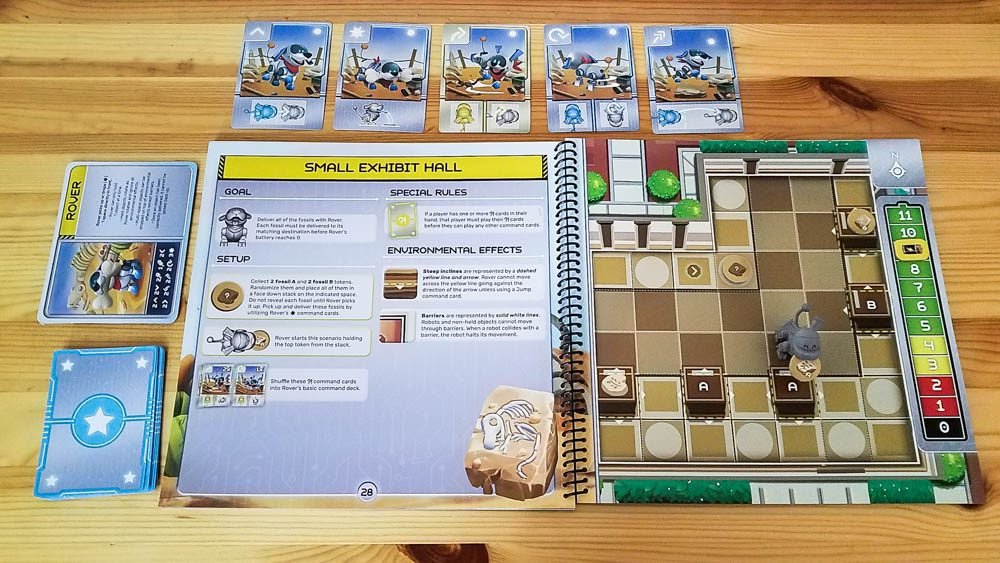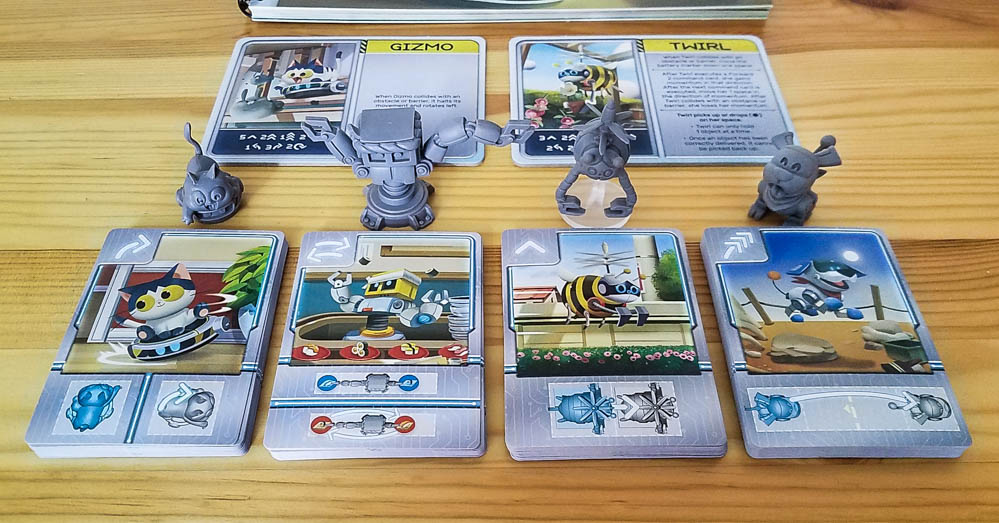Quirky Circuits Review
Year: 2019 | Players: 2-4 | Minutes: 15-30 | Ages: 7+
This Quirky Circuits review was made after playing the game 10 times. We were sent a copy of this game by the publisher in exchange for an honest review.
What is Quirky Circuits?
Quirky Circuits is a cooperative, limited communication, programming game in which you’re attempting to program your robots to complete tasks before their batteries are drained.
Quirky Circuits was designed by Nikki Valens and is published by Plaid Hat Games.
Rules Overview
In each game of Quirky Circuits, you’ll choose a scenario in the scenario book, read any special rules for that scenario, and then set up the board, which is on the opposite page in the scenario book. Each player will have command cards that control the robot’s movements, and you’ll need to work together to move the robot around and complete the scenario’s goal before its battery runs out.
What makes the game challenging is that you can’t say anything about the cards in your hands. The backs of the cards give everyone some information, like if they’re going to be movement or turn cards, but they don’t tell you the distance or direction the robot will move.
There are three phases in each round of Quirky Circuits:
- Program – You have to collectively play at least five command cards face-down and everyone has to play at least one card. If you have any of the robot’s special yellow cards in your hand, you have to play those before you can play any of your other cards.
- Execute – Flip the cards that were played one at a time and move the robot accordingly. Each scenario has rules for what happens when the robots run into things or move into certain zones.
- Reset – All of the used command cards are shuffled back into the deck, the battery is drained one step, and everyone draws back up to their hand size.
There are four different robots in the game, each coming with their own sets of cards and scenarios. Gizmo the kitty-bot needs to clean up dust bunnies around the house, but tables, chairs, cats, and other things can make it tough to navigate the rooms. Lefty’s job is to grab food off of a conveyor belt and feed the cats. Twirl has to keep the garden in great shape by planting seeds and feeding the koi fish and mice. Rover the doggy-bot has to help open a new museum by digging up and delivering dinosaur fossils. There are also some special/advanced scenarios that change up the robots’ goals.
You’ll win if you’re able to complete the scenario’s goal before the robot’s battery is drained. Some scenarios also have other ways that you can lose.
Pros and Cons
Pros
- Quirky Circuits is a lot more challenging than I was expecting, which was a nice surprise. One misread can throw everything off, which can turn into some hilarious moments where your robot spins a couple times and ends up in a completely different spot than you were expecting. Each robot’s early scenarios are easier than the rest, but even those aren’t auto-wins.
- I always like when there are opportunities to make “Hail Mary” plays in board games, and you can definitely have those moments in Quirky Circuits. If your robot gets down to its last bit of power, you can play 10+ cards to see if you can pull off the unexpected win at the last second. Very cool.
- I like that each robot’s scenarios get progressively tougher. It allows you to get used to their movements and abilities as you play.
- There’s plenty of replay value here. The game has 25 scenarios and, once you beat them, you can always try to beat your high scores or increase the difficulty.
- The rules aren’t complicated at all, but it’s still great that you can find every scenario’s unique rules right next to their map.
- Quirky Circuits works for all ages and experience levels, which is something I haven’t been able to say about many other co-ops. I really do feel like I can play this with anyone.
- It also plays well at all player counts. Four-player games are a bit tougher since all four players still have to play at least one card each round, which can be challenging, but other than that it’s the same experience.
- The four robot miniatures look fantastic. They’re the same style as the miniatures found in Stuffed Fables, which I was also a big fan of. Gizmo the Roomba-riding cat is just awesome.
Cons
- The commands on the cards can confuse and frustrate some people. The “left” and “right” cards seem to cause the most problems. If someone has a tough time seeing things from the robot’s perspective on the board, they can accidentally throw everything off.
- There are these speech bubbles in Lefty’s scenarios that look pretty bad and don’t blend into the map as well as everything else. They’re just these big white circles when they probably should have been more transparent.
Final Thoughts
Quirky Circuits is one of the better cooperative board games for families that I’ve played in the last year or so. It’s a unique experience that blends together some of my group’s favorite mechanisms, so I wasn’t too surprised that it ended up being a big hit with us. I’ve enjoyed all of my plays of it so far and the fact that I can break it out with absolutely any group means that it’ll probably stay in my collection for a while.
If your gaming group enjoys limited communication games like The Mind, Hanabi, and Magic Maze, chances are you’re going to enjoy Quirky Circuits. If you also happen to be a fan of programming games… yeah, this is a must-have.
- Update: Quirky Circuits made it onto the Top Cooperative Board Games of 2019 list!
- Update 2: It’s also now on our Best Cheap Board Games page!
Quirky Circuits Links
BGG | Amazon | Miniature Market
Thanks for taking the time to read our Quirky Circuits review!
To stay updated on all things cooperative board games, follow us on Twitter, Facebook, or via RSS.



